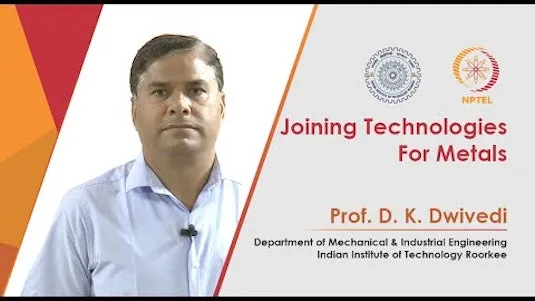
Welding (Mechanical Engineering) 
This course provides an introduction to welding for Mechanical Engineering students. It covers the classification and gas welding of LEC 1, gas welding and thermit welding of LEC 2, resistance welding of LEC 3, arc welding of LEC 4, and TIG, MIG, and SAW welding of LEC 5. It is designed to help students prepare for the RRB JE exam. ▼
ADVERTISEMENT
Course Feature
![]() Cost:
Cost:
Free
![]() Provider:
Provider:
Youtube
![]() Certificate:
Certificate:
Paid Certification
![]() Language:
Language:
English
![]() Start Date:
Start Date:
On-Demand
Course Overview
❗The content presented here is sourced directly from Youtube platform. For comprehensive course details, including enrollment information, simply click on the 'Go to class' link on our website.
Updated in [May 25th, 2023]
This course provides an overview of welding techniques used in mechanical engineering. In the first lecture, students will learn about the classification and gas welding of RRB JE. The second lecture will cover gas welding and thermit welding for RRB. The third lecture will focus on resistance welding for RRB JE. The fourth lecture will cover arc welding. The fifth lecture will cover TIG, MIG, and SAW welding for RRB LEC. By the end of the course, students will have a comprehensive understanding of welding techniques used in mechanical engineering.
[Applications]
The application of this course in Mechanical Engineering is to provide students with the knowledge and skills necessary to become proficient in welding. Students will learn the different types of welding, such as gas welding, thermit welding, resistance welding, arc welding, and TIG, MIG, and SAW welding. They will also learn the safety precautions and techniques for each type of welding. After completing this course, students should be able to apply their knowledge and skills to welding projects in the workplace. Additionally, they should be able to identify and troubleshoot welding problems.
[Career Paths]
1. Welding Engineer: Welding Engineers are responsible for designing, developing, and testing welding processes and equipment. They also oversee the production of welded components and ensure that the welding process meets safety and quality standards. As the demand for welded components increases, the need for Welding Engineers is expected to grow.
2. Welding Technician: Welding Technicians are responsible for setting up and operating welding equipment. They must be knowledgeable in the use of various welding techniques and materials, and must be able to interpret blueprints and drawings. As the demand for welded components increases, the need for Welding Technicians is expected to grow.
3. Welding Inspector: Welding Inspectors are responsible for inspecting welded components to ensure that they meet safety and quality standards. They must be knowledgeable in the use of various welding techniques and materials, and must be able to interpret blueprints and drawings. As the demand for welded components increases, the need for Welding Inspectors is expected to grow.
4. Welding Fabricator: Welding Fabricators are responsible for fabricating welded components. They must be knowledgeable in the use of various welding techniques and materials, and must be able to interpret blueprints and drawings. As the demand for welded components increases, the need for Welding Fabricators is expected to grow.
[Education Paths]
1. Mechanical Engineering: Mechanical engineering is a broad field that involves the design, development, and production of machines and tools. It is one of the oldest and broadest engineering disciplines, and it is a popular choice for students interested in pursuing a career in engineering. Mechanical engineering is a rapidly growing field, and it is expected to continue to grow in the coming years. Mechanical engineers are responsible for designing, developing, and testing machines and tools, as well as developing new technologies and processes.
2. Welding Engineering: Welding engineering is a specialized field of engineering that focuses on the design, fabrication, and testing of welded components and structures. Welding engineers are responsible for ensuring that welded components and structures meet the required safety and performance standards. They also develop welding processes and procedures, and they are involved in the development of new welding technologies.
3. Robotics Engineering: Robotics engineering is a field of engineering that focuses on the design, development, and implementation of robots and robotic systems. Robotics engineers are responsible for designing, developing, and testing robots and robotic systems, as well as developing new technologies and processes. Robotics engineering is a rapidly growing field, and it is expected to continue to grow in the coming years.
4. Automation Engineering: Automation engineering is a field of engineering that focuses on the design, development, and implementation of automated systems. Automation engineers are responsible for designing, developing, and testing automated systems, as well as developing new technologies and processes. Automation engineering is a rapidly growing field, and it is expected to continue to grow in the coming years.
Course Provider

Provider Youtube's Stats at AZClass
Discussion and Reviews
0.0 (Based on 0 reviews)
Explore Similar Online Courses

Azure Security and Compliance

CS50s Understanding Technology

Python for Informatics: Exploring Information

Social Network Analysis

Introduction to Systematic Review and Meta-Analysis

The Analytics Edge

DCO042 - Python For Informatics

Causal Diagrams: Draw Your Assumptions Before Your Conclusions

Whole genome sequencing of bacterial genomes - tools and applications

Welding Safety

Fundamental of Welding Science and Technology

Joining Technologies For Metals
 Related Categories
Related Categories
 Popular Providers
Popular Providers
Quiz
 Submitted Sucessfully
Submitted Sucessfully
1. Which type of welding is used to join two pieces of metal together?
2. Which type of welding is used to join two pieces of metal together without melting the base metal?
3. Which type of welding is used to join two pieces of metal together with the use of an electric arc?


Start your review of Welding (Mechanical Engineering)